Click on images to enlarge

habit (Photo: Trevor James)

paired leaves (Photo: Trevor James)
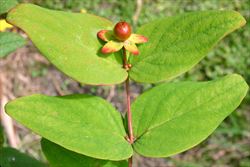
close-up of stem and leaves (Photo: Trevor James)
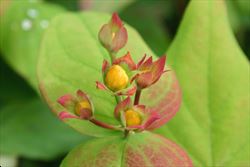
flower buds (Photo: Trevor James)

flower cluster (Photo: Matt Taylor)
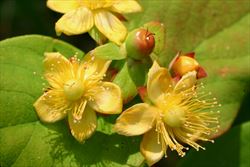
flowers with numerous stamens (Photo: Trevor James)
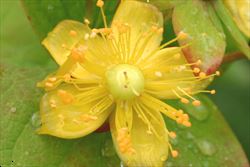
close-up of flower showing ovary topped with three small styles (Photo: Trevor James)

close-up of young fruit (Photo: Trevor James)

close-up of immature fruit (Photo: Trevor James)
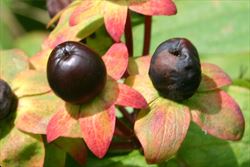
close-up of mature fruit (Photo: Trevor James)
Scientific Name
Hypericum androsaemum L.
Synonyms
Androsaemum officinale All.Androsaemum vulgare Gaert.
Family
Clusiaceae (Queensland,
Guttiferae (
Common Names
amber, hypericum, St. John's wort tutsan, sweet amber, tutsan
Origin
This species is native to southern and western Europe, North Africa and Asia Minor (i.e. the Mediterranean region).
Cultivation
Tutsan (Hypericum androsaemum) has been cultivated as a garden ornamental in the temperate regions of Australia.
Naturalised Distribution
This species is most common and widespread in southern and north-eastern Victoria. It is locally abundant is some parts of Tasmania and eastern New South Wales. Also sparingly naturalised in the ACT and possibly naturalised in south-western Western Australia.
Habitat
A weed of temperate regions that prefers damp and shaded habitats. It is usually found in closed forests, forest margins, open woodlands, waterways, waste areas and sometimes also in pastures.
Habit
A small, upright (i.e. erect), long-lived (i.e. perennial) shrub usually growing 0.3-1 m tall, but occasionally reaching up to 1.5 m or more in height.
Distinguishing Features
- a small long-lived shrub usually growing up to 1 m tall with slender, somewhat woody, slightly winged stems.
- its green or reddish leaves are oppositely arranged, hairless, and either stalkless or stem-clasping.
- its flowers (1.5-3 cm across) have five yellow petals and five greenish-coloured sepals that are almost the same size.
- its fleshy berries (7-12 mm across) are initially green in colour but turn red and then purplish or blackish as they mature.
Stems and Leaves
The stems are slender, somewhat woody and with two ridges or small 'wings'. Several of these branching stems usually emerge from a woody crown at the base of the plant each year. The tips of these stems are usually reddish in colour when young.
The leaves (3.5-15 cm long and 3-8 cm wide) are usually bright green in colour, but often have a distinct reddish hue during autumn. These leaves are oppositely arranged along the stems, hairless (i.e. glabrous), and stalkless or stem-clasping (i.e. sessile). They are either egg-shaped in outline (i.e. ovate), oval (i.e. elliptic) or oblong and have entire margins. Crushed leaves give off a distinctive 'curry-like' smell.
Flowers and Fruit
The yellow flowers (1.5-3 cm across) are borne in small clusters, each containing 2-15 flowers, at the tips of the branches. They have five petals (6-12 mm long) and five persistent greenish-coloured sepals that are nearly as long as the petals. Each flower also has numerous stamens and an ovary topped with three styles. Flowering occurs during spring and summer.
The fruit are initially green but turn red and then purplish or black in colour as they mature. They are fleshy, globular berries (7-12 mm across) containing numerous seeds. These seeds are brown in colour, ridged, and about 1 mm long.
Reproduction and Dispersal
This species reproduces by seed. These seeds may be dispersed by vehicles, machinery and water, but are most commonly spread by birds and other animals that eat the fruit. They may also be spread in mud, contaminated agricultural produce and dumped garden waste.
Environmental Impact
Tutsan (Hypericum androsaemum) is regarded as a significant environmental weed in Victoria and as an environmental weed in New South Wales and Tasmania. It is also seen as a potential environmental weed in Western Australia and is listed as a priority environmental weed in two Natural Resource Management regions.
This species is a serious weed of temperate rainforests, moist sclerophyll forests, open woodlands and riparian areas in temperate Australia. It often form dense stands that smother the ground flora and smaller shrubs in the understorey of native bushland. Tutsan (Hypericum androsaemum) tolerates deep shade and prefers damp, shaded sites and forest edges, but can also establish in open, sunny locations. It competes strongly with native species can invade undisturbed bushland. Whole hillsides may be covered to the exclusion of most other vegetation.
Tutsan (Hypericum androsaemum) is currently of most concern in Victoria, where it is regarded as a serious threat to damp and wet sclerophyll forests, warm and cool temperate rainforests and riparian vegetation. This species appears on several environmental weed lists in Victoria (e.g. in Colac Otway Shire, the Shire of Yarra Ranges, Nillumbik Shire, Knox City, Banyule City, Kingston City and the Goulburn Broken Catchment) and has been declared noxious in some regions. It is common in the Otway, Strzelecki and Dandenong Ranges and has invaded several conservation areas in this region (e.g. Sherbrooke Forest and Morwell National Park). For example, a one location near Mansfield, it is the dominant species extending from a roadside for several hundred metres into native bushland, greatly reducing the density of native species.
In New South Wales, tutsan (Hypericum androsaemum) is mainly of concern in the wider Sydney and Blue Mountains region. It is listed as an alert weed in the Sydney North region and is a weed of bushland and conservation areas in the Blue Mountains area (e.g. in Pitt Park and in the Jenolan Caves Reserve). Infestations of tutsan (Hypericum androsaemum) have also been reported in Kosciuszko National Park, in southern New South Wales.
Other Impacts
Tutsan (Hypericum androsaemum) encroaches into overgrazed pastures in Victoria. It is also suspected of poisoning cattle in New Zealand, and of causing skin ailments in livestock.
Legislation
This species is declared under legislation in the following states and territories:
- Victoria: C7 - a regionally controlled weed in the Corangamite, Port Phillip West, Port Phillip East, Goulburn, North East, West Gippsland and East Gippsland regions, where landholders must take all reasonable steps to control it and prevent its spread on their land and the roadsides which adjoin their land.
- Western Australia: P1 - trade, sale or movement into the state prevented, and P2 - to be eradicated (throughout the entire state).
Management
For information on the management of this species see the following resources:
- the Western Australian Department of Agriculture and Food information page on this species, which is available online at http://www.agric.wa.gov.au.
Similar Species
Tutsan (Hypericum androsaemum) is very similar to flair tutsan (Hypericum x inodorum) and relatively similar to St. John's wort (Hypericum perforatum), Canary Island St. John's wort (Hypericum canariense), St. Peter's wort (Hypericum tetrapterum) and tangled hypericum (Hypericum triquetrifolium). These species can be distinguished by the following differences:
- tutsan (Hypericum androsaemum) has relatively large and broad leaves (5-15 cm long and 3-8 cm wide) that are egg-shaped in outline (i.e. ovate), oval (i.e. elliptic) or oblong in shape. The yellow flowers are relatively large (2-3 cm across) and have five persistent green-coloured sepals that are nearly as long as the petals. Its fruit are fleshy, globular berries (8-12 mm across) that turn red and then purple or black as they mature. Its leaves give off a distinctive curry-like odour when crushed.
- flair tutsan (Hypericum x inodorum) has relatively small and broad leaves (usually about 5 cm long) that are egg-shaped in outline (i.e. ovate) or oblong in shape. The yellow flowers are relatively large (about 2.5 cm across) and have five persistent green-coloured sepals that are nearly as long as the petals. Its fruit are fleshy, globular or elongated berries that turn red or pink and then black as they mature. Its leaves do not give off a strong odour when crushed.
- St. John's wort (Hypericum perforatum) has relatively small and narrow leaves (5-40 mm long and 1.5-12 mm wide) that are narrowly egg-shaped in outline (narrowly-ovate) to elongated (i.e. lanceolate or linear) in shape. The yellow flowers are relatively large (1-3 cm across) and their petals are much longer than their sepals. Its fruit are dry capsules (5-10 mm long) that turn brown when they mature.
- Canary Island St. John's wort (Hypericum canariense) has relatively large and narrow leaves (2-7 cm long and 1-2 cm wide) that are narrowly oval (i.e. elliptic) to elongated (i.e. lanceolate) in shape. The yellow flowers are relatively large (2.5-3 cm across) and their petals are much longer than their sepals. Its fruit are dry capsules (5-10 mm long) that turn brown when they mature.
- St. Peter's wort (Hypericum tetrapterum) has relatively small leaves (up to 3 cm long) that are egg-shaped in outline (i.e. ovate) to narrowly oval (i.e. elliptic) in shape. The yellow flowers are relatively small (about 12 mm across) and their petals are much longer than their sepals. Its fruit are dry capsules (5-10 mm long) that turn brown when they mature.
- tangled hypericum (Hypericum triquetrifolium) has small leaves (5-15 mm long) that are arrowhead-shaped and usually borne closely appressed to the stems. The yellow flowers are relatively small (10-15 mm across) and their petals are much longer than their sepals. Its fruit are small dry capsules (3-4 mm long) that turn brown when they mature.
There are other native and naturalised Hypericum species in Australia, however these plants are usually smaller in stature and their fruit are dry capsules.

